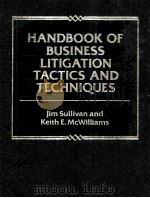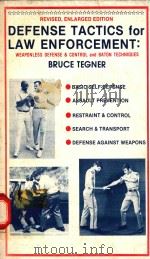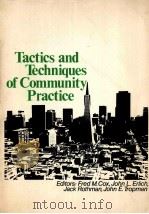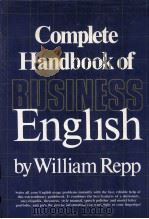《HANDBOOK OF BUSINESS LITIGATON TACTICS AND TECHNIQUES》
| 作者 | 编者 |
|---|---|
| 出版 | PRENTICE HALL |
| 参考页数 | 236 |
| 出版时间 | 1988(求助前请核对) 目录预览 |
| ISBN号 | 0133759814 — 求助条款 |
| PDF编号 | 812922458(仅供预览,未存储实际文件) |
| 求助格式 | 扫描PDF(若分多册发行,每次仅能受理1册) |

Chapter 1: How to Get Off on the Right Foot as a Business Litigator: Say What You Mean When You Write and Speak1
Eliminate the Use of Legal Mumbo-Jumbo2
Substitute English for Latin4
How to Avoid the "Cover-All-the-Bases Syndrome"4
How to Avoid Conflicting and Inconsistent Theories4
State the Question and the Issue at the Outset5
Use Plain Words and Short Sentences6
Place the Emphasis on Pictures, Graphics and Movies7
Avoid Technical and Fashionable Lingo7
Seven Litigation Rules to Live By8
Chapter 2: Getting Better Litigation Results by Estimating What to Expect and How Much They'll Cost17
Pick the Trial Team First18
Estimate the Cost of the Lawsuit18
Budget the Case19
Use a Decision Tree to Value the Case20
Use Jury Instructions as a Guide to Issues21
Consider a Protective Order24
Chapter 3: How to Assess the Merits of a Jury Demand49
Points to Consider When Making Your Decision52
Punitive Damage Claims53
Business Tort Claims53
Duration of Trial53
Complexity of Evidence53
Extent of Disposition Testimony53
Budget Constraints53
Judicial Impatience54
Anti-Corporate Bias54
Chapter 4: How to Make Videotape an Essential Technique in Winning High-Tech Litigation57
Videotaped Conference Depositions58
State Courts59
Conducting the Videotape Deposition59
Other Uses of Videotape61
Videotape Places and Things62
How Videotape Leads to Settlement Enhancement64
Buying the Basic Gear64
Editing Guidelines65
Effective Use of Videotape at Trial66
Use to Cross-Examine69
Use During Final Argument69
Sample Orders for Videotaping70
Chapter 5: Seizing and Maintaining Control of Your Case77
Threshold Preparation77
Jury Instructions77
Learn About the Business78
Prepare a Chronology and Glossary78
Find Out About Your Client78
Get the Lowdown on Your Adversary78
Keep Your Trial Team Lean79
Before Discovery Gather Available Evidence81
Putting the Trial Touches on Discovery Preparation82
How to Analyze the Computerized/Manual Issue Index Question82
Deciding Tour Needs for Computer or Manual Support85
Handling Motion Practice85
Producing Defensive Documentation86
Responding to Adversary Requests87
Offensive Document Examination91
Discovery of Parties91
Discovery of Non-Parties91
Discovery of Computerized Evidence92
Depositions93
Chapter 6: How to Beady Your Witnesses for Trial95
Preparing Them for Depositions95
Preparing to Horseshed Major Role Witnesses100
The Final Drill106
Horseshedding Your Leading Role Witnesses for Trial Requires Different Tactics107
Communicating in the Courtroom107
Chapter 7: Making Better Use of Cross-Examination in High-Tech Litigation117
Before Trial117
Obtain Oreganizational Charts118
Conduct a Power Structure Probe118
Prepare a Hit List of Your Adversary's Top Brass119
Do Break the Cardinal Rule for Cross-Examination125
Do Not Allow Unnecessary Questions126
Do Not Tolerate Certain Adversary Instructions126
Cross-Examination During Trial127
Preparing a "Zinger" Cross-Examination Videotape127
Do Not Try to Capture New Tuff127
Plough New Ground Discreetly129
Chapter 8: When and How to Use Expert Testimony to Present Facts and Probe Damages133
Determining What Kind of Expert You Need133
Handling the Expert Witness Relationship138
Frequently Encountered Damage Problems144
Causation144
Accuracy of Estimates144
Measuring Lost Profits and Decline in Market Share144
Measuring Overcharges146
Measuring Reduction in the Value of a Business146
Measuring True Value Versus Inflated Value in Securities Fund Cases147
Some Other Uses of Experts148
Unfair Competition149
Geographic Price Differences149
Predatory Pricing by a Dominant Company150
Monopoly and Attempted Monopoly Cases151
Chapter 9: Using Successful Negotiation Techniques to Avoid Lengthy and Risky Litigation155
Why Lead Counsel Should Not Be the Chief Negotiator155
How to Use Professional Negotiator Techniques156
Prepare a Powerful and Modem Settlement Brochure for the Settlement Judge164
Prepare Modem and Tight Settlement Agreements166
Chapter 10: Success-Proven Final Preparation Rules173
Discard the Weak Claims173
Reduce the Size of the Trial Team174
Using Summary Exhibits175
Arrange Audio-Visual Aids for Maximum Impact177
Do a Comprehensive Evidence Review179
Using Threshold (in limine) Motions to Preclude, and Trial Ground Rules180
Chapter 11: How to Pick a Good Jury185
Questions to Ask Prospective Jurors185
The Case for Blue Ribbon Juries188
Obtain Background Information on Jurors188
Consider These New Developments in Jury Selection189
Deciding Upon the Type of Juror You Want190
Chapter 12: Opening Arguments That Win Business Cases193
Be a Salesman193
Aids for the Salesman194
Be a Spokesman194
Use Charts194
Create a Good Impression194
Speak Directly to the Jury194
What You Must Tell the Jury195
Continue to Use the Rule of Seven196
Winning Pitch—Examples199
Chapter 13: Helping Juries to Understand Cases207
Give the Jury a Short Course207
Give the Jury the Instructions at the Start of the Case208
Use Other Learning Aids to Help the Jury Understand209
Let Jurors Ask Questions210
Use the Modern Mode and Order of Presentation of Evidence210
Use Videotape During Trial210
Treating Ordinary Employees of an Adverse Party as Neutral Third Parties212
Give Jurors a Booklet Covering Each Side's Final Argument212
Chapter 14." Techniques That Win Business Litigation Cases215
How to be Persuasive215
How to Keep It Concise216
How to Recall Your Opening Argument217
How to Use Visual Aids and Graphics217
How to Talk to the Jury During the Close218
A Winning Pitch Example219
Index229
1988《HANDBOOK OF BUSINESS LITIGATON TACTICS AND TECHNIQUES》由于是年代较久的资料都绝版了,几乎不可能购买到实物。如果大家为了学习确实需要,可向博主求助其电子版PDF文件(由 1988 PRENTICE HALL 出版的版本) 。对合法合规的求助,我会当即受理并将下载地址发送给你。
高度相关资料
-

- FIELD HOCKEY TECHNIQUES & TACTICS
- Human Kinetics
-

- Handbook of the Law of corporations and other business enterprises
- 1970 West Publishing CO.
-

- HANDBOOK OF HISTOPATHOLOGICAL AND HISTOCHEMICAL TECHNIQUES THIRD EDITION
- 1974 BUTTERWORTH & CO PUBLISHERS LTD
-

- DEFENSE TACTICS FOR LAW ENFORCEMENT:WEAPONLESS DEFENSE AND CONTROL AND BATON TECHNIQUES
- 1972 THOR PUBLISHING GO.
-

- HANDBOOK OF PALEONTOLOGICAL TECHNIQUES
- 1965 W.H.FREEMAN AND COMPANY
-

- LABORATORY HANDBOOK OF PETROGAPHIC TECHNIQUES
- 1974 A WILEY-INTERSCIENCE PUBLICATION
-

- HANDBOOK OF CONSTRUCTION TECHNIQUES
- A MCGRAW-HILL PUBLICATION
提示:百度云已更名为百度网盘(百度盘),天翼云盘、微盘下载地址……暂未提供。➥ PDF文字可复制化或转WORD







